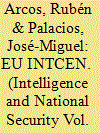|
|
|
Sort Order |
|
|
|
Items / Page
|
|
|
|
|
|
|
| Srl | Item |
| 1 |
ID:
173962


|
|
|
|
|
| Summary/Abstract |
This article aims to gain a better understanding of EU INTCEN’s analytic culture and the use of structured analytic techniques by EU analysts; an under researched topic in the intelligence studies literature. The Intelligence Analysis and Situation Centre of the European Union (EU INTCEN) is a directorate of the European Union External Action Service (EEAS) that has been characterized as an EU analytic structure similar to the State Department’s INR. The article reviews relevant literature and presents findings based on the analysis of a questionnaire on ‘Intelligence analysis and production in EU INTCEN/SITCEN, that was distributed to EU INTCEN intelligence analysts (EEAS officials having worked as analysts in EU SITCEN/INTCEN between June 2005 and June 2014), and in-depth phone interviews to better understand INTCEN analytical process. Analytic projects at EU INTCEN are initiated with Requests for Information to which replies can be received. The analysts count as well with previous contributions and assessments, open sources, and diplomatic reporting. Among other findings, the study reveals that SATs are little used in practice in spite of most EU INTCEN analyst has received some training on SATs.
|
|
|
|
|
|
|
|
|
|
|
|
|
|
|
|
| 2 |
ID:
164194


|
|
|
|
|
| Summary/Abstract |
Structured analytic techniques (SATs) are intended to improve intelligence analysis by checking the two canonical sources of error: systematic biases and random noise. Although both goals are achievable, no one knows how close the current generation of SATs comes to achieving either of them. We identify two root problems: (1) SATs treat bipolar biases as unipolar. As a result, we lack metrics for gauging possible over-shooting—and have no way of knowing when SATs that focus on suppressing one bias (e.g., over-confidence) are triggering the opposing bias (e.g., under-confidence); (2) SATs tacitly assume that problem decomposition (e.g., breaking reasoning into rows and columns of matrices corresponding to hypotheses and evidence) is a sound means of reducing noise in assessments. But no one has ever actually tested whether decomposition is adding or subtracting noise from the analytic process—and there are good reasons for suspecting that decomposition will, on balance, degrade the reliability of analytic judgment. The central shortcoming is that SATs have not been subject to sustained scientific of the sort that could reveal when they are helping or harming the cause of delivering accurate assessments of the world to the policy community.
|
|
|
|
|
|
|
|
|
|
|
|
|
|
|
|
| 3 |
ID:
147583


|
|
|
|
|
| Summary/Abstract |
Despite intense scrutiny and promised fixes resulting from intelligence ‘transformation’ efforts, erroneous analytic assessments persist and continue to dominate news coverage of the US intelligence community. Existing analytic training teaches analysts about common cognitive biases and then aims to correct them with structured analytic techniques. On its face, this approach is eminently reasonable; on close inspection, incomplete and imbalanced. Current training is anchored in a mid-twentieth century understanding of psychology that focuses on checking over-confidence and rigidity but ignores the problems of under-confidence and excessive volatility. Moreover it has never been validated against objective benchmarks of good judgment. We propose a new approach: (a) adopting scientifically validated content and regularly testing training to avoid institutionalizing new dogmas; (b) incentivizing analysts to view training guidelines as means to the end of improved accuracy, not an end in itself.
|
|
|
|
|
|
|
|
|
|
|
|
|
|
|
|
| 4 |
ID:
149293


|
|
|
|
|
| Summary/Abstract |
This article presents findings from the first publicly available survey generalizable to an intelligence agency to explore why analysts use structured analytic techniques (SATs). Mandated by the Intelligence Reform and Terrorism Prevention Act (2004), SATs are simple methodologies supposed to make analysis more transparent and, hopefully, valid. Despite the US government’s investment in training thousands of analysts, there is no solid evidence on how often or why analysts actually use SATs. A survey of 80 analysts and nine follow-up interviews at the State Department’s Bureau of Intelligence and Research reveals a simple, but important, truth: implementing the techniques requires training and compelling evidence they will improve analysis. Other factors, most notably the amount of time pressure an analyst experiences, were not significantly related with the use of the techniques despite anecdotal accounts and conjecture from the literature. Future research should examine other intelligence agencies to cross-validate these findings. If these findings hold in other cases, intelligence agencies should focus on reforming and incorporating evidence into the training process.
|
|
|
|
|
|
|
|
|
|
|
|
|
|
|
|
|
|
|
|
|